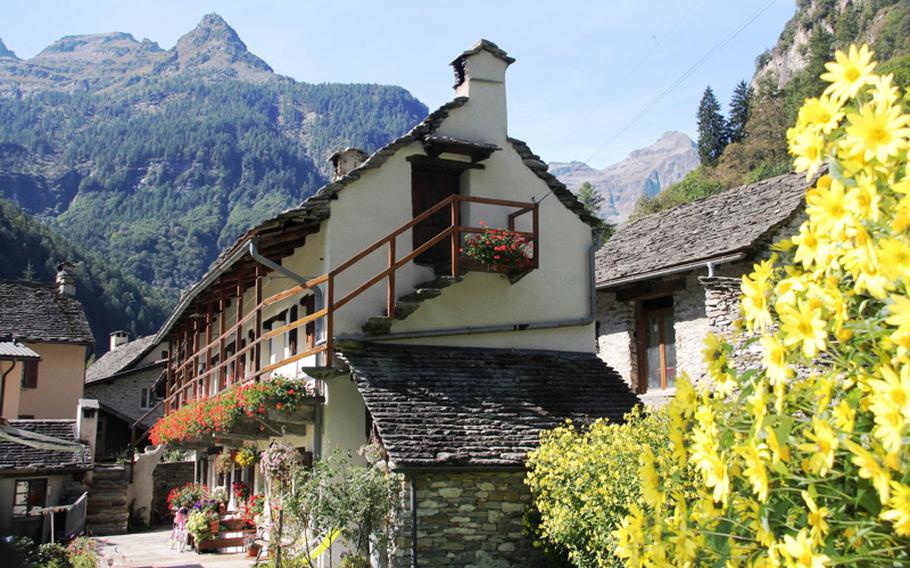
Village of Sognogno offers plenty of photo opportunities in the Swiss canton of Ticino. (Leah Larkin/Special to Stars and Stripes)
It’s on the southern, sunny side of the Alps. The language is Italian. The people are lively and gregarious. It’s la dolce vita in Switzerland, specifically in the canton, or state, of Ticino, a region of grandiose mountains and gleaming lakes almost entirely surrounded by Italy.
Ticino has more than 130 small Alpine lakes. Its major cities, Bellinzona, Lugano and Locarno, are also pleasant to visit. Lugano, Switzerland’s third-largest banking city after Zurich and Geneva, is noted for international flair, classy shopping venues and splendid botanical gardens. In Bellinzona, a city with three medieval castles, cable cars glide above the city. Ride up for the views, then set out on one of many hiking trails.
In my younger days, I spent a summer in this captivating region as a leader of a group of university students. They were French majors and were supposed to enhance their language skills by staying with Swiss families. (Switzerland has four official languages: German, French, Italian and Romansch.) But Italian is the home language in Ticino. Most Swiss are multilingual, and fortunately all was not lost as French also was spoken in the homes. My home stay “father” introduced the group to mountain hiking. I have since enjoyed many a strenuous trek to Swiss peaks.
During a recent Ticino visit, I joined a group for a less demanding, leisurely walk. From the village of Arosio, we set out on the Chestnut Trail, a walk of 10 kilometers (just over six miles) through a forest of magnificent trees, past fields and into ancient villages. Though we followed a guide, the Chestnut Trail, like most Swiss trails, is well marked. You can easily do it on your own.
Until the 1960s, we learned, chestnuts were an important food source for the inhabitants of this region.
The nuts were harvested for the production of flour. “The people were very poor here. The chestnut was the bread of the community,” 70-year-old Giuseppe Tami told us. We met Tami at an old stone building known as a Ra Gra in the forest. The forests used to have many such structures with special fireplaces that were used to dry the chestnuts over smoky heat. This building has survived and still is used every October when local residents come to harvest the fruit of the trees. We continued on, passing groups of goats wandering freely on the hillsides. We crossed streams, stopped for photos and wandered through picture-perfect mountain villages. Not on the Chestnut Trail, but pure enchantment, is Sognogno, the quintessential Ticino village and the highlight of my recent Ticino journey. The cluster of worn and weathered stone buildings is at the end of a narrow road that snakes up the Verzasca Valley high above a gorge with a surging mountain river below. A 500-year-old Roman bridge spans a section of the rushing river. The village, its stone houses all decorated with flower boxes overflowing with color, is dwarfed by rugged peaks. I could not put my camera to rest. Craftswomen employed by Sognogno’s Casa della Lana (wool house) spin and dye the wool using only natural substances, such as birch leaves or hazel leaves, to produce vivid colors: magenta, gold, turquoise. Their shop offers pullovers, cardigans and scarves as practical, but pricey, souvenirs. The Grotto Redorta is the perfect place for lunch with its rustic interior and inviting terrace next to a slope of grapevines. In Ticino, risotto and/or polenta, rather than pasta, are usually on the menu. Polenta with gorgonzola tempted me. I expected a portion of polenta with a bit of melted cheese on top. Instead, I got a plate with a mound of polenta and a huge chunk of cheese next to it . . . not for the calorie-conscious.The road to Sognogno passes below Switzerland’s smallest commune, Corippo, a museum of a town with just 17 inhabitants. The only way to reach Corippo is on foot. The site is so steep it’s said the chickens wear diapers to keep their eggs from rolling down the incline. “I recommend everyone go there once,” a guide said. “You feel like you’re in another world.”A reason for me to return to Ticino. Photojournalist Leah Larkin lives in France and can be contacted through her website, leahlarkin.com, or blog address, http://talesandtravel.com.